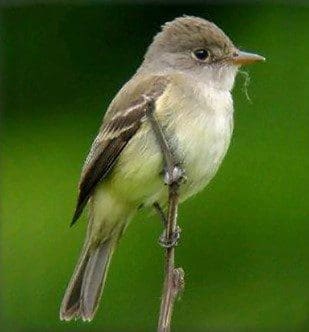The Southwestern Willow Flycatcher

WHAT SMALL, FEDERALLY ENDANGERED BIRD IS SHOWING SIGNS OF A SOMEBACK IN WETLANDS PARK?
Back in 1995, the U.S. Fish and Wildlife Service (FWS) listed the southwestern willow flycatcher (Empidonax trailii extimus) as a federally endangered species. At that time, it was known to breed in only 75 riparian areas throughout the American southwest and the known breeding population was estimated at between 300 and 500 pairs (600 to 1,000 birds).
The flycatcher is a small, perching bird, less than 5-3/4 inches long from the tip of its bill to the tip of its tail. It weighs less than .5 ounce. It has a brownish-olive to gray-green upper body, a whitish throat contrasting with a pale olive breast, a pale-yellow belly, and two light wing bars. Males and females have the same plumage, but juveniles differ from adults by having buffy wing bars. If you are fortunate enough to view this bird up close, you will notice a completely yellow lower beak and the lack of a conspicuous eye ring. Like other willow flycatchers, it has a distinctive sneezy “fitz-bew” song, gives “whit” and “brrrit” calls, and often flicks its tail upward when perched.
It turns out these birds are picky when it comes to habitat. They require a moist microclimate with lots of vegetation and will only breed in dense riparian vegetation near surface water or saturated soil. While wet conditions are uniformly required, the structure and species of vegetation in which they nest varies by region and availability. While migrating, they will tolerate a small patch of prime grounds, but while they are nesting/breeding they are even pickier about space and will “move on” if things aren’t just right. They are also territorial, defending their breeding territory, which is often clumped with nearby territories of other flycatchers in a colony. During migration, they can occupy territory solo or near other flycatchers. Males will exhibit site fidelity by returning to the general area of the previous year’s breeding grounds. Because of the dynamic nature of riparian habitat (e.g., a single flood can destroy an entire patch), flycatchers are known to move among sites in their breeding grounds, either within the same year or from year to year.
The flycatchers spend only three to four months paired with a mate for the breeding season. Males arrive on breeding grounds in late April to early May to establish territories, approximately one to two weeks before the females arrive. After pairing, the female builds a small, open cup nest from leaves, grass, fibers, feathers, and animal hair, approximately 3.2 inches high and 3.2 inches wide (outside dimensions). She meshes it into the fork of a tree branch, with the nest typically supported by several small-diameter upward-angling support stems. Nests are placed from three to 36 feet above the ground. Preferred plants for this are willows and more recently, tamarisk.
In late May to early June, the female lays three to four buff-colored eggs (with brown markings) in a circle. She incubates them for about two weeks. Then, both parents tend their young during the 12 to15-day nestling stage. After fledging, the young stay close to the nest for another two weeks. During this time, both adults cater to the loudly begging fledglings for food.
Southwestern willow flycatchers like to eat “on the fly,” literally. They dart out from their perch in short flights to catch insects in mid-air, or hover to glean insects from foliage. They forage during the day, inside and above the canopy, along patch edges and openings in their territory, and above surface water, catching prey as diverse as ants, dragonflies, bees, wasps, flies, mosquitoes, gnats, midges, cicadas, and aphids.
Back in the late 1990’s when flycatcher populations reportedly dwindled, the situation looked grim. The biggest reason for population decline was the loss and degradation of dense, native riparian habitats to engineered dams, water diversion for agriculture, and groundwater pumping. Other reasons included stream bank stabilization, vegetation control, livestock grazing, off-road vehicle use, increased fires, and urban development. Also, there was a push by other interest groups to merge this subspecies with another flycatcher subspecies.
Fortunately, through the implementation and ongoing refinement of the bird’s Federal recovery plan (first completed in 2002) and careful monitoring of the bird through surveys, the FWS was able to expand critical flycatcher habitat to 1,975 stream kilometers by 2013. This included the Park, under the auspices of the Las Vegas Wash Coordination Committee.
While flycatcher surveys have been conducted at the Park for the past 25 years, 2023 was the first summer biologists found that there were with multiple breeding territories and nests with eggs, nestlings, and most importantly: at least one young bird surviving long enough to leave the nest, hopefully to return in the future to establish its own breeding territory.
The backstory: a permitted environmental consultants banded three, seven to nine-day-old chicks, allowing for identification for the rest of their lives using specific color sequences. Field staff returned several days later to confirm fledging (i.e., young leaving the nest). The nest was empty, and the adults were nearby feeding one fledgling, the youngest from banding day. The two older nestlings were not seen but were hopefully in the area and just exhibiting greater independence.
This historic achievement is the result of dramatic changes at the Wash over the years, especially the establishment of native vegetation and improved hydrology, and creating high-quality habitat for the flycatcher.
By: Constance Carlson, Director of Communications; photo credits as indicated.
Please enjoy this YouTube video:
Willow Flycatcher – Fitz-bew!
